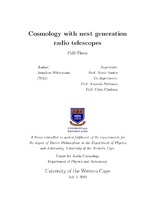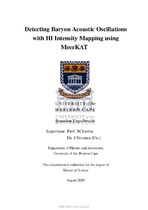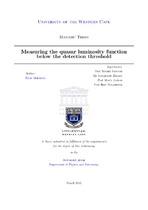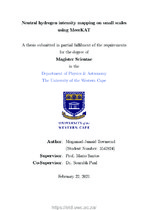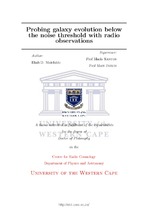Browsing by Author "Santos, Mario"
Now showing items 1-9 of 9
-
Cosmology with HI intensity mapping: effect of higher order corrections
Randrianjanahary, Liantsoa Finaritra (University of the Western Cape, 2020)One of the main challenges of cosmology is to unveil the nature of dark energy and dark matter. They can be constrained with baryonic acoustic oscillations (BAO) and redshift space distortions, amongst others. Both have ... -
Cosmology with next generation radio telescopes
Witzemann, Amadeus (University of the Western Cape, 2019)The next generation of radio telescopes will revolutionize cosmology by providing large three-dimensional surveys of the universe. This work presents forecasts using the technique 21cm intensity mapping (IM) combined ... -
Detecting Baryon Acoustic Oscillations with HI Intensity Mapping using MeerKAT
Engelbrecht, Brandon (University of the Western Cape, 2019)Future radio surveys as the Square Kilometer Array (SKA) and its precursor, the "Meer" Karoo Array Telescope (MeerKAT), will map the Neutral Hydrogen (HI) in large areas of the sky using the intensity mapping (IM). HI ... -
Measuring the quasar luminosity function below the detection threshold
Malefahlo, Eliab (University of the Western Cape, 2016)The radio emission of radio-quiet active galactic nuclei (AGN) is thought to be from star formation and AGN related emission. I investigate these sources using 1.4 GHz radio data from FIRST and three optical quasars samples ... -
Neutral hydrogen intensity mapping on small scales using MeerKAT
Townsend, Mogamad-Junaid (University of the Western Cape, 2021)In the post-reionisation universe, intensity mapping (IM) with the 21 cm line of neutral hydrogen (HI) provides a potential means of probing the large-scale structure of the universe. With such a probe, a wide variety of ... -
Neutral hydrogen intensity mapping on small scales using MeerKAT
Townsend, Mogamad-Junaid (University of the Western Cape, 2021)In the post-reionisation universe, intensity mapping (IM) with the 21 cm line of neutral hydrogen (HI) provides a potential means of probing the large-scale structure of the universe. With such a probe, a wide variety of ... -
Point source simulations and Foreground cleaning techniques for HI intensity mapping
Ngobese, Sibonelo (University of the Western Cape, 2018)We created a full sky point source catalogue at frequencies around 1 GHz, including the intensity, polarisation, rotation measure and spectral index of the point source. These values were matched to data where available ... -
Probing galaxy evolution below the noise threshold with radio observations
Malefahlo, Eliab D (University of the Western Cape, 2020)The faint radio population consisting of star forming galaxies (SFG) and radio-quiet active galactic nuclei (AGN) is important in the study of galaxy evolution. However, the bulk of the faint population is below the ... -
Reconstruction of the ionization history from 21cm maps with deep learning
Mangena (University of the Western Cape, 2020)Upcoming and ongoing 21cm surveys, such as the Square Kilometre Array (SKA), Hydrogen Epoch of Reionization Array (HERA) and Low Frequency Array (LOFAR), will enable imaging of the neutral hydrogen distribution on ...


